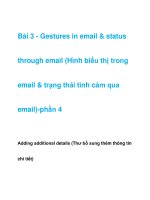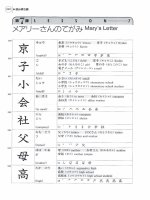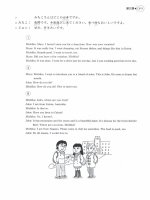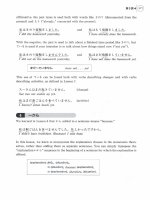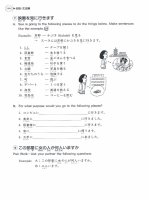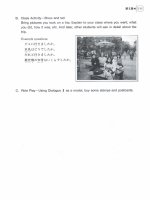genki 1 an integrated course in elementary japanese1 phần 3 pdf
Bạn đang xem bản rút gọn của tài liệu. Xem và tải ngay bản đầy đủ của tài liệu tại đây (3.8 MB, 31 trang )
rhh1L1
&&EX.
7.
9
7
1)
-
5
x/ta
n
2
F
=/~"<LW
{
QI
d2
(
+k~>Tlrf-lr*,
Mearii
san
wa
Rondon
daigaku
no
gakusee
desu
ka.
8.
i?=
Cj
L
3
AE3
tziQk*~\cil"*k~,
Takeshi
san
wa
ninensee
desu
ka.
-f
i
9.
2-3
xlta
L~~;&A+?L\TT&~~
Suu
san
wa
ichinensee
desu
ka.
5EhY
10.
a/<
k
3
hid
tah*~~TTh~,
Robaato
san
wa
yonensee
desu
ka.
Nationality
I
American
1
Japanese
I
Korean
I
British
I
Japanese
I
B.
Pair
Work-Ask
your
partner
whose
belongings
items
(1)
through
(7)
are.
Your
School
Major
Year
partner
will
refer
to
the
picture
on
the
next
page
and
answer
the
questions.
*&I)bl
Example:
A
:
ZhGd
%7')-3h@
SL\,<~TT$~,
Kore
wa
Mearii
san
no
saifu
desu
ka.
U.
of
Arizona
Japanese
2nd
year
lie,
Mearii
san
no
saifu
ja arimasen.
1
6.
A
:
'I-~&cT)
S~h,iXrfh~,
Kore
wa
Rii
san
no
saifu
desu
ka.
9
b>
B
:
22,
')-SLa
~L\LST-$-~
Ee,
Rii
san
no
saifu
desu.
Tozai
Univ.
history
4th
year
Seoul
Univ.
computer
3rd
year
U.
of
London
business
Tozai
Univ.
(Japanese
teacher)
4th
year
*&9bb
97')-
Mearii
ajz
Yoo
ko
@
b
&a@
#"Lh
1/
@
3
(Review
Exercises)
A.
Role
Play-One
student
is
a
store
attendant.
The
other
is
a
customer.
Use
Dialogue
I
as
a
model.
B.
Role
Play-One
student
is
a
waiter/waitress.
The
other
student
goes
to
a
restaurant.
Look
at
the
menu
below
and
order
some
food
or
drink,
using
Dialogue
II
as
a
model.
Pair
work
@
C.
Example:
A
:
2
XlV9
tA
t:
(
l;
TTha,
Enpitsu
wa
ikura
desu
ka.
Hyaku
en
desu.
Pair
Work
@
D.
Example:
Customer
:
z
13
63
l\
(
6
TT
fixo
Kono
hon
wa
ikura
desu
ka.
Store
attendant
:
C=+X/iY+
(
Z
hTT,
Nisen
hyaku
en
desu.
Card
B
I
Ex.
(3)
Part
I.
You
are
a
customer.
Ask
for
the
price
of
items
(1)-(5).
Part
11.
You
are
a
store
attendant.
TeIl
the
customer
how
much
each
item
is.
Pair
Work
@)
Example:
A
:
LkLba
fs#'L@
h'sTTi3',
Kore
wa
dare
no
kasa
desu
ka.
Kl&'lt>
6
:
%7'1-3/La
&+TTo
Mearii
san
no
kasa
desu.
Picture
B
-f
5
2-
Suu
Takeshi
Mearii
Robaato
Yamashita
sensee
Iln
the
Classroom
Useful
Expressions
b15.3
3
I#
k,
I
understand.
/I
understood.
Wakarimashita.
&?$%!I
a%&,
I
don't
understand./I
don't
know.
Wakarimasen.
@=I
(
rJ
bh7-C
(
~SSL~~
Please
speak
slowly.
Yukkuri
itte
kudasai.
&
9
~6
Z*
L~I
f
{
f2-3
LL~
Please
say
it
again.
Moo
ichido
jtte
kudasai.
I
G17Z
37T(?S3hl
Please
wait.
Chotto
matte
kudasai.
?-ba$g%
Making
a
Date
a
Mary
and
Takeshi
are
talking.
@
On
Sunday
morning,
at
Mary's
host
family's.
Takeshi:
Mary,
what
do
you
usually
do
on
the
weekend?
Mary:
Let's
see.
I
usually
study
at
home-
But
I
sometimes
see
movies.
Takeshi:
I
see
,
.
.
then,
would
you
like
to
see
a
movie
on
Saturday?
Mary:
Saturday
is
not
a
good
day.
(lit-,
Saturday
is
a
little
bit
[inconvenient]
-
.
.
)
Takeshi:
Then,
how
about
Sunday?
Mary:
That's
fine.
Mary:
Good
morning.
Host
mother:
Good
morning.
You
are
early,
aren't
you?
Mary:
Yes,
I'm
going
to
Kyoto
today.
1
will
see
a
movie
in
Kyoto.
Host
mother:
Good.
Around
wht
time
will
you
come
back?
Mary:
Around
nine.
Host
mother:
How
about
dinner?
Mary:
I
will
not
eat.
Host
mother:
I:
see.
Well,
have
a
nice
day.
Mary:
Good-bye.
Enterfuinment
and
Sports
Foods
and
Drinks
ak,
5
Z"II
h
s
3
t-f
3-t-
*
t3XI
X/
Places
t
15
*
9%
Time
&
5
bi
Lk
L
\9
*
915
*
Z
h23*."h
*
L@929
*
r'k-iilP
*
ltGk
5v
movie
music
magazine
sports
date
(romantic,
not
calendar)
tennis
TV
video
tape;
VCR
$fi%@x
bf-eakf
ast
i%%
sake;
alcohol
%%
green
tea
coffee
Y%&t&
dinner
hamburger
&@I@
lunch
$
water
home;
house
home;
house;
my
place
language
Iab
school
morning
tomorrow
when
today
at
about
tonight
weekend
Saturday
Sunday
*
Words
that appear
in
the
dialogue
Irregular
Verbs
<
b
*
-jt-g
*
+L~L~T&
%%TG
Adverbs
;ti
3
9
4-
negative
-E
+?*
k
4-
negative
&%
*
f;~\ft\
A*
*
Gdr7Z
r3r"3
Q.;T
k
<
Expressions
*
+=,
TT12a
*
T&
*
z*?
TjW
4tE
every
day
3
k\tr&
3
t\t$X/
-@a
every
night
U-verbs
*
L\
{
*
ha&&
'4
.
("
a)$'
13
Q
3-
to
go
(destinatian
t
I/%)
to
go
back;
to
return
(destination
i=
to
listen;
to
hear
(-
2
to
drink
(-4)
to
speak;
to
talk
(hng?cage
2lT)
to
read
(-2)
to
get
up
to
eat
(-
%
)
to
sleep;
to
go
to
sleep
to
see;
to
look
at;
to
watch
to
come
(destinatks
1~/2)
to
do
(-4)
to
study
(-2)
good
early
not
much
not
at
all
usually
a
little
sometimes
-
often;
much
&.
That's
right.;
kt
me
see.
hut
How
about
.
.
.
?;
How
is
.
.
.
?
Grammar
13
i%
I$3
Verb
Conjugation
Verbs
in
Japanese
conjugate,
or
take
various
shapes.
In
this
lesson,
we
learn
three
forms:
(1)
the
"dictionary
forms,"
(2)
the
present
tense
affirmative
forms,
and
(3)
the
present
tense
negative
forms.'
There
are
two
kinds
of
verbs
that
follow
regular
conjugation
patterns,
and
an
example
of
each
is
beloiv.
1
ru-verb
u-verb
1
/
verb
bases
tabe
ik
dictionary
forms
(to
eat)
E<
(to
90)
~
LI
present,
affirmative
&<bb
5SZT
L)
present, negative
&<a@h
stems
i4
t;
&-;.
4
belongs
to
the
group
of
verbs
called
the
"ru-verbs."
RZL-verbs
are
so
called,
because
you
add
the
suffix
ru
to
the verb
base
(tabe,
in
the
above
example)
to
form
the
dictionary
form.
For
the
two
long
forms we
learn
in
this
lesson,
you
simply
add
the
suffixes
mnszc
and
masen,
instead
of
YU,
to
the
bases.
We
learn
four
ru-verbs
in
this
lesson:
Another
major
group
of
verbs
is
called
the
"u-verbs."
The
dictionary
form
of
an
a-verb
like
fi
{
can
be
broken
down
into
the
base
(ik
in
fie
above
example)
and
the
suffix
u.
The
I1
long
forms
like
$T
1
3
-if
and
6
3
3
*
h,
then,
are
formed
with
the
base
plus
suffixes
1
>
I%
imsu
and
imasen.
You
may
find
the
u-verb
conjugations
sIightly
more
difficult
than
the
ru-verb
conjugations, because
of
the
extra
vowel
i.
We
learn
six
u-verbs
in
this
lesson:
h he
use
of
the
term
"dictionaxy
forms"
is
by
no
means
restricted
to
listings
in
a
dictionary.
They
also
appear
in
various
constructions in actual sentences.
We
will
learn
their
uses
in later
chapters.
Don't
be
misled
by
the
names
given
to
the
long
foms
too;
the
"present
tense"
in
Japanese
can
indicate
both
the
"present"
and
the
"future."
We
will
return
to
this
issue
in
Section
2
below.
For
the
moment,
we
will
concentrate
on
the
foms,
not
the
meaning
of
these
verbs.
In
later
lessons,
we
will
have
many
opportunities
to
refer
to
the
parts
like
$k<
and
E
3,
t
I
r
which
come
before
3
T
and
3
*A
in
the
long
forms.
For
the
sake
of
ease
of
reference,
we
will
call
these
parts
(same
as
bases
with
ru-verbs,
and
bases
plus
i
with
a-verbs)
"stems."
In
addition
to
ru-verbs
and
u-verbs,
there
are
two
"irregular
verbs."
Note
that
the
voweIs
in
their
bases
are different
in
the short
(dictionary)
forms
and
the
long
forms.
irregular
verbs
dictionary
forms
present,
affirmative
present,
negative
35
(to
do)
l/S*
tBeh
1
sterns
b
<
Q
(to
come)
$25
3beh
These
two
verbs
are
also
used
to
form
compound
verbs.
In
this
lesson,
we
learn
the
verb
&S
9
6,
which
conjugates
just
like
the
verb
-;f
8.
*L?'i?
It
is
important
to
remember
which
verb
belongs
to
which
conjugation
class.
It
is
a
good
idea,
therefore,
to
memorize
each
verb
as
a
set:
instead
of
memorizing
just
the
dictionary
form,
try
to
memorize
the
dictionary
form
and
the
present
tense
affirmative,
like
;T;i-
<
-
L
L
$7
3
f
T.
This
is
especiaIly
important
with
verbs
that
end
with
the hiragam
b,
because
tl
they
may
be
irregular
verbs
like
3-
b
and
(
6,
or
ru-verbs,
or
u-verbs
whose
bases
just
happen
to
end
with
the
consonant
r.
If
you
know
the
verb
classes
and
the
rules
that
apply
to
them,
you
know
why
it
is
wrong
to
say
X
IL
1
3
9
and
XHir
4
-f.'
K
d'*
EB
(=
a
ru-verb)
(=
an
u-verb
that
ends
with
5)
B
fiz
verb
bases
mi
kaer
long
forms
W,d$/Sbt%
P
W
%I'T
h'x
$S!9%6/IIbD$Wh,
stems
E!
a9
Eu3
7i'X
'Things
are
not
as
bad
as
you
might
expect
after
reading
the
above
paragraph.
The
key
lies
in
the
second
from
the
last
syllable in
a
dictionary
form.
The
irregular
verbs
set
aside,
if
you
see
the
vowels
a,
o,
or
u
right
before
the
final
4,
you
can
be
absolutely
sure
that
they
are
a-verbs.
(We
have
not
learned
any
such
verbs
yet.)
Unfortunately
for
us,
the
logic
does
not
follow
in
the
other
direction;
there
are
m-verbs
and
u-verbs
that
have
the
vowels
i
and
e
before
the
final
4.
25
has
the
vowel
e
before
4
and
is
a
I>
ru-verb.
'R
8,
on
the
other
hand,
has
the
same
sound
sequence,
but
is
an
u-verb.
n-
L
In
this
lesson
we
learn
about
a
dozen
verb
that
describe
basic
human
actions.
Thew
are
often
called
"action
verbs,"
and
the
"present
tense''
of
these
verbs
either
meam
(I)
that
a
pezs'son
habitually
or
regularly
engage
in
these
activities,
or
(2)
that
a
person
will,
or
is
planning
to,
perform
these
activities
in
-the
future.
Habitual
actions:
1
often
watch
TV.
%
7
I)
-
3
k
I3
Z
3
~"3
$1
c"b3X/
2
3
-kkxl,
Mary
sometimes
doesn
't
eat
breukfarf.
A
i
f:
Future
actions:
1
will
go
to
Kyoto
taorrow.
Sue
will
nof
return
home
today.
Nauns
used
in
sentences
~rnerd1y
must
be
foll.2awed
by
gar&icIes,
which
indicate
the
relations
that
the
nouns
bear
to
the
verbs.'
Ia
this
lesson,
we
learn
four
particles:
T,
kc,
".,
and
8.
T
The
particle
T
indicates
where
the
event
described
by
the
verb
takes
placee4
HS%T*2%&&T0
r
L
*&X-ISX.
1
I
will
read
books
iz
the
library.
-i
GzTt/Y$Rf
To
L,
I
will
watch
TV
at
home.
(L
The
particle
G=
has
many
meanings,
but
here
we
will
learn
two:
(1)
the
goal
toward
which
things
move,
and
(2)
the
time
at
which
an
event
takes
pIace.
(I)
goal
of
movement
I
will
lzot
go
to
school
today.
1
milk
retarn
home.
3~n
spoken
language,
particles
are
often
"dropped."
We
will
learn
more
about
such
cases
in
Lesson
15.
"In
later
Iessons,
we
will
be
introduced to
verbs
that
require
particles
other
than
T
to
express
location.
-
-
.
(2)
time
I
will
go
to
Kyatu
on
Sunday-
1
will
go
to
bed
at
elmera.
(Some
time
words
stand
alone, without
the
particle
C:
tagging
along,
which
will
be
discussed
in
Section
4
below.)
Approximate
time
references
can
be
made
by
substituting
2"5
or
r'5
1:
for
t:.
Thus,
-+-%<*&
(I=)Ef
To
I
will
go
to
bed
at
ubout
ekeves.
L'm-illij
U
h
4
The
particle
2,
too,
indicates
the
goal
of
movement.
The
sentences
in
(1)
above
there-
fore
can
be
rewritten
using
instead
of
I:.
Note
that
this
particle
is
pronounced
"e."
Note
that
-
may
replace
the
particle
it
only
in
the
goal-of-movement
sense.
The
particle
4:
for
time
references and
other
uses,
which
we
will
learn
about
in
later
lessons,
cannot
be
so
replaced.
The
particle
2
indicates
"direct
objects,"
the
kind
of
things
that
are
directly
involved
in,
or
affected
by,
the
event.
Note
that
this
particle
is
pronounced
"o."
I
liste~
to'
tapes.
I
watch
TV.
You
need
the
particle
br
with
U)
the
days
of
the
week
like
"on
Sunday,"
and
(2):
numerical
time
expressions,
like
"at
lo:&,"
and
"in
September."
1
get
up
at
l0:42.
I
will
go
buck
in
September.
You
do
not
use
the
particle
C:
with
(I)
time
expressions
defined
relative
to
the
present
moment,
such
as
"today"
and
"tomorrow,"
(2)
expressions
describing
regular
intervals,
such
as
"every
day,"
and
(3)
the
word
for
"when."
1
will
cme
tmrrow.
1
watch
TV
ezlery
ewming.
When
will
you
go?
You
normally
do
not
use
G:
with
(1)
the
parts
of
a
day,
like
"in
the
morning"
and
"at
night,"
and
(2)
the
word
for
"weekend."
Unlike
words
like
ih
L
fz
and
4P!!
above,
how-
3
rxrrx.
ever,
these
words
are
sometimes
followed
by
G:,
depending
on
styles,
emphases,
and
personal
preferences.
I
read
the
newspaper
ia
the
morning.
What
will
you
do
on
weekends?
You
can
use
2
I=
the
present
tense
negative
verb,
plus
the
question particle)
to
extend
an
invitation.
It
should
be
noted
that
its
affirmative
counterpart,
2
TBs,
canlzot
be
so
used.
Thus
a
sentence
like
&5TlatL
Q
3
33.
can
only
be
construed
as
a
question,
U
5
t:
not
as
an
invitation.
What
do
you
say
to
having
lunch
with
me?
Sou~ds
great.
Wikl
you
play
temzis
with
me?
Um,
it's
slightly
(zmmoenimf
for
me
nt
thiq
mmmt).
Japaue
sentences
are
fairly
flexibie
in
€he
arrangement
of
ekments
that
appew
in
them.
Generally,
sentences
are
made
up
of
se~esai
noun-particle
sequences
followed
by
a
verb
QP
an
adjective,
which
in
turn
is
often
fallowed
by
a
sentence-final
particle
such
as
a=,
&,
ou
k
.
Among
ihe
noun-partick
sequences,
their
relative
orders
are
b
a
large
extent
&ee.
A
typical sentence,
therefore,
looks
like
the
following,
but
several
other
arrangements
of
noun-particle
sequences
are
also
possible.
L
T
a+zg
%BL$T,
bf:L
?ii
Y
Lkd-X.
1-
13X,
:
+32?
topic
time
place
object
verb
1
will
study
Japanese
a'=
the
&raw
today.
wa
dt:
4=%tv5
3%-
wo
*f:L
Lt;
U
5.5
topic
frequency time
goal
verb
I
ofken
go
back
home
at
around seva.
You
can
add
a
frequency
adverb
such
as
-&El
(everyday),
k
(
(often),
and
Z
3
~'3
3
r,l-tj
(sometimes)
to
a
sentence
to
describe
how
often
you
do
something.
1
smtimes
go
to
a
coffee
shop.
In
thisjesson,
we
also
learn
two
adverbs
which
describe
how
izfrequmt
an
activity
or
an
/
_
-'
event
is; +??A+Fk
(never;
not
at
all)
and
25
3
'I
(not
often;
not
very
much).
These
adverbs
anticipate
the
negative
at
the
end
of
the
sentence.
If
you
use
*X/+frt
or
25
2
1
,
in
other
words,
you
need
to
conclude
the
sentence
with
1
*A.
I
do
mt
watch
TV
at
all.
Takahi
dues
nut
sfudy
much.
As
we
saw
in
Lesson
I,
the
particle
M
presents
~e
topic
of
one's
utterance
("As
for
item
X,
it
is
such
#at.
.
.").
It
puts
forward
the
item
that
you
want
to
talk
about
and
comment
an,
You
may
have
noted
that
the
topic
phrases
in
sentences
such
as
%
7
'1
-
3
ttME%ik
SLh&ict>
TT
(Mary
is
a
third-year
student),
and
%~3SBE3id
B
+S?T
(My
major
is
Japanese
&&L
*A,&&
4:
ItL
2
language),
are
the
subjects of
those
sentences.
A
topic
phrase,
however,
need
not
be
the
subject
of
a
sentence-
We
see
three
sentences
in
the
dialogue
of
this
lesson
where
rmonsubject
phrases
are
made
topics
with
the
help
of
the
particle
kt.
rrr
'I
%A,
ssrat=t~~t\~~
L~T~~,
bj33
Mary,
mhuf
do
jorr
usually
do
FIE^
we~kmd?
+s
Ea3@c=.SSji
3g-,
3x3
IliZ
t>
I'm
gozng
to
Kyoto
todoy.
In
the
above
two
examples,
Cd
promotes
time
expressions
as
the
topic
of
each
sentence.
Its
effects
can
be
paraphrased
like
these:
"Let's
talk
about
weekends;
what
do
you
do
on
weekends?"
"Let
me
say
what
I
will
do
today;
I
will
go
to
Kyoto."
RZ*ldAfld
?
rr/v
How
about
dinner?
In
this
example,
Id
is
used
rn
directing
the
listener's
attention
and
thereby
inviting
a
comment
or
completion
of
a
sentence.
You
may
also
note
that
the
broached
topic,
R
t*ld
rzd,
A,
does
not
stand
in
subject
relation
to
the
verb,
but
is
rather
its
direct
object.
~s!/-b
Expression
Notes@)
fi</%S
b
When
you
move
to
a
place
where
the
hearer
is,
you
say
"I'm
Ll
<
coming."
in
English.
However
in
the
same
situation,
SEAEf3
3
T
is
used
in
L
L,
Japanese.
SfFB
is
a
movement
toward
the
place where
the
speaker
is.
5
<
<
CI
is
a
movement
in
a
direction
away
from
the
speaker.
speaker's
viewpoint)
I
5
&
3
&b
G
dr
3
2
literally
means
'<a
little,''
"a
bit,"
"a
small
amount,"
as
in
%
k
7
2
<
FSts
IPIease
give
me
a
Little)
and
3
r
7
2%-T
(
fZScl
%
(Please
wait
for
a
moment).
It
is
commonIy
used
for
a
polite
refusal.
In
this
I
case,
it
means
"inconvenient,"
"impossible,"
and
so
on.
Japanese
people
don't
narmdy
reject
requests,
suggestions,
or
invitations
with
t
3
t
3
A
(No),
/
because
it
sounds
too
direct.
A
:
*@El
t~%fi@E%
%!tLfi~p
Will
YOU
seg
a
movie
on
Saturday?
EL3
fJ
ft3s
A
l3
:*EEli&.
t3&-3k0
F
k3
IF
Saturduy
is
not
convmimt-
(lit.,
Saturday
is
a
little
bit*)
Pract
;ncv
L93
ice
@ZKP*Z~%T
k
ha
I%tb
A.
Change
the
following
verbs
into
-23
and
bI?h.
@
B.
Look
at
the
pictures
below
and
make
sentences using
the
cues.
@
(a)
Add
the
appropriate
verbs
to
the
following direct
objects.
Example:
$k%
+
%%PS$k3To
7-
L
3.
>
.
<
-,
-
Ex.
%%
r;<
L
(1)
7
-7O
coffee
shop/3:00
college/every
day
(b)
Add
the
place
to
the
above
sentences.
Example:
library
+
E!/%@-c="%%
??
s-4
3
To
YLrd.A
YTL
2
C.
Lwk
at
the pictures
below
and
make
sentences
using
the
cues.
@
Example:
go
to
the
post
office
+
%@6
i=e
3
3
To
WjWX.3ri
tb
(I)
go
to
the
library
(2)
come
to
school
Ex.
go
to
the
post
office
(3)
come
to
the
coffee
shop
(4)
return
home
Sunday
(5)
return
to
the
U.
S.
tomorrow
D.
Pair
Work-Make
questions,
using
verbs
we
have
learned
in
this
lesson.
Example:
A
El~@T%S~S4$.T6~o
L
"c-t
I
8
:
22,
%&2-j-,/~\~\2,
%A$*&,
a a
E.
Pair
Work-Guessing
game
Ask
questions
and
find
out
the
items
your
partner
has
chosen.
i
1.
Before
you
start,
both
of you
will
choose
one
item
in
each
row
of
the
table
and
mark
it.
2.
In
each
row,
using
the
verb and
one
of
the
four
items,
make
a
yes-or-no-
question
sentence
and
find
out
which
item
your
partner
has
chosen.
3-
You
can
ask
at
most
two
questions
with
one
verb.
If
you
have
guessed
correctly
the
item
your
partner
has
chosen,
you
score
a
point.
Your partner
will
not
give
away
the
right
answer
when
you
ask
a
wrong
question.
j
4.
When
you
have
asked
questions
about
all
the
verbs
in
the
table,
switch
roles
with
your
partner
and
answer
their
questions.
!
5.
Tabulate
the
score.
You
win
the
game
if
you
have
scored
higher
than
your
partner.
Example:
A
:
%Eice?
i#$dh,
At-:
j
IN
I3
:
't>~vE,
e3
&*,Lo
L.
A
:%&*-fi3f
T75%
3
7
rx
6
la
L
h,
fi
3
2
To
(A
guessed
what
B
marked,
therefore
A
won.)
I.
library
cartoon(
2
h.69
coffee
Japanese
book
tennis
I373
i,
3
-2K3-P
A
-2eka2-p
rn
i2%&3-T
L
%La?
coffee
shop
video
water
magazine
telephone
post
office
TV
sake
book
date
school
movie
green
tea
newspaper
study
A.
Look
at
Mary's
schedule and
answer
the
following
questions.
@
Mary's
Schedule
7:30
A.M.
get
up
8:OO
eat
breakfast
8:30
go
to
school
12:OO
eat
lunch
3:00
P.M.
drink
coffee
4:OO
play
tennis
500
go
home
6:30
eat
dinner
7:OO
watch
TV
8:OO
study
11
:30
go
to
bed
13.
Pair
Work-Ask
your
partner
what
time
they
do
the
following
things.
Example:
A
:
fi%
41%
3
2
T$ao
r,.&
U
%
Your
partner's
schedule
time
1
get
UP
(
)
eat
breakfast
)
go
to
school
)
eat
lunch
(
)
go
home
,
(
)
go
to
bed
C.
Look
at
the
pictures
in
I-B
(p.
65)
and
I-C(p.
66),
and
add
the
time
expressions
to
the sentences.
@
Example:
2:00
+
=%i=B%@?*??%&$T,
C:
L'
r
L
1h.k
M/Y
rt
@
~-k-anasvhn\
a
A.
Make
suggestions
using
the
cues
below.
@
Example:
drink
coffee
+
3
-
k
-
5?
&A
3
a',
0
I.
see
a
movie
4.
eat
dinner
7.
drink
tea
at
home
2.
come
to
my
house
5.
study
in
the
library
8.
listen
to
the
music
3.
play
tennis
6.
talk
at
a
coffee
shop
B.
Pair
Work-Ask
your
friend
out
for
the
activities
in
the
pictures.
Example:
A
:
f&Eh
2
2
+?
k
h.,
1
;
k
B
:
L\L\TT~,/
j
j
A,
Gk
7
Z ,
Ex.
Baa*esaaq
SLI
[=%ah
a
How
often
do
you
do
the
following
activities?
Answer
the
questions
using
the
expressions
below.
Example:
Q
:
*&%h3T.hxo
1tX
a
A
:
22.
1
<
:%A2-$-o/~~b~2.
9%&3*h*
I I
@
2
&&(nsg
(Review
Exercises)
%LhrL@3
A.
Answer
the
following
questions.
B.
Tell
your
classmates
what
your
plans
are
today/tomorrow/on
the
weekend.
Example:
48LA=~l=LLG=~33~,
Z%~ZH~@CB+%B&~&L~T~
i-i
1:
U
u~mc
I*
5X.
t
Y
C
16.k
I:
lih
:
-v/vfi
C.
Class
Activity-Find
someone
who
.
.
.
I.
gets
up
at
7
o'clock.
2.
eats
breakfast
every
day.
3.
speaks
French.
4.
watches
TV
at
home.
5. listens
to
Japanese
music.
6.
plays
tennis.
name
D.
Suggest
to
a
classmate
that
you
do
something
together
over
the
weekend.
Use
Dialogue
I
as
a
model.

